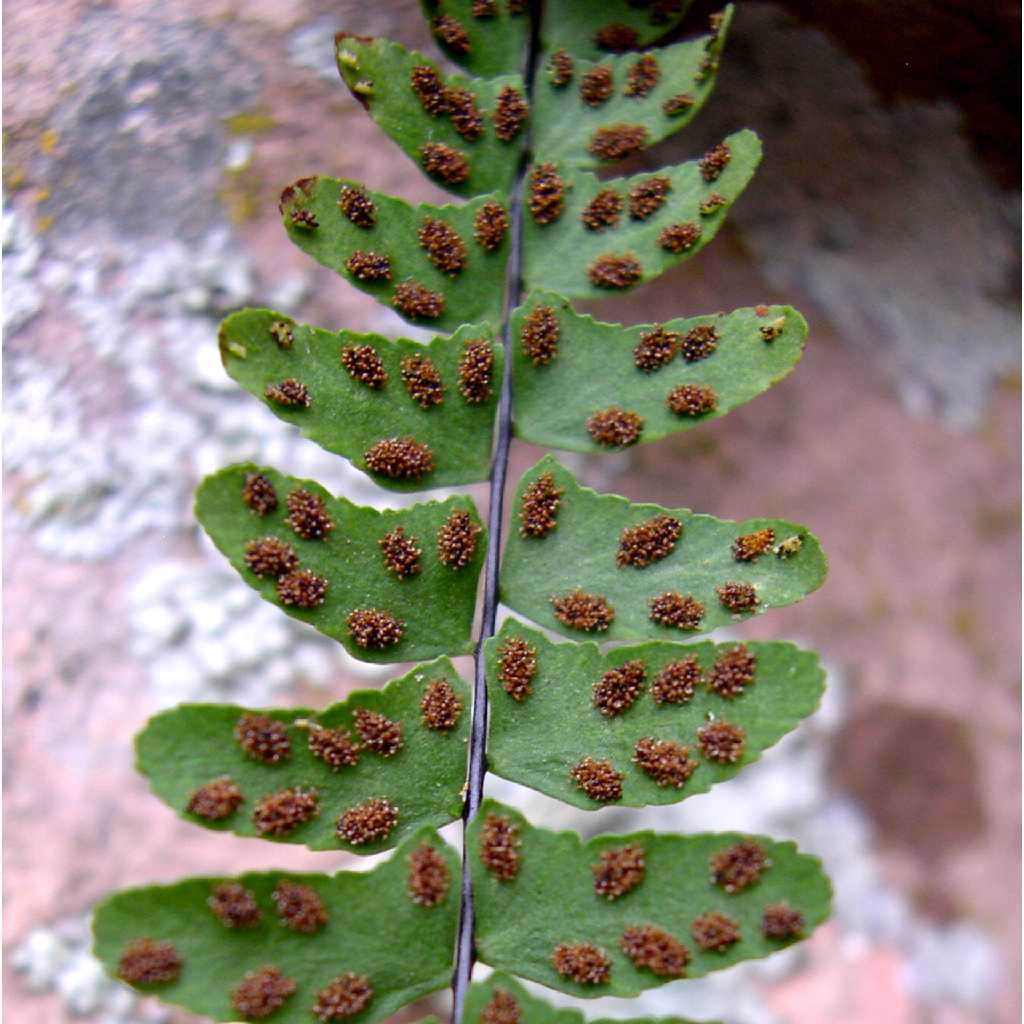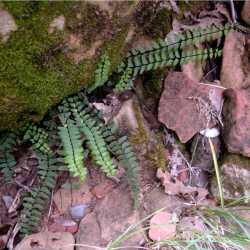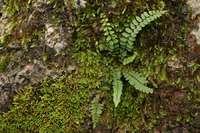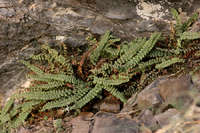|
|
|
|
Family: Aspleniaceae
blackstem spleenwort
|
Roots not proliferous. Stems erect, unbranched; scales black throughout, linear-lanceolate, 4--5 × 0.2--0.6 mm, margins entire. Leaves monomorphic. Petiole black throughout, lustrous, 1.5--3(--5) cm, 1/4--1/10 length of blade; indument of blackish brown, filiform scales. Blade linear to narrowly oblanceolate, 1-pinnate throughout, 9--20(--30) × 1--2(--2.5) cm, thick, glabrous; base gradually tapered; apex acute, not rooting. Rachis black throughout, lustrous, glabrous. Pinnae in 20--40 pairs, oblong; medial pinnae (5--)10--20 × (2--)3--5 mm; base usually with an acroscopic auricle; margins ± entire to shallowly crenate; apex obtuse. Veins free, obscure. Sori 2--5 pairs per pinna, on both basiscopic and acroscopic sides, often confluent with age. Spores 32 per sporangium. n = 2 n = 108 (apogamous). Cliffs, sinkholes, on limestone or other basic rocks; 100--1500 m; Ala., Ariz., Ark., Del., Fla., Ga., Ill., Kans., Ky., La., Md., Miss., Mo., N.Mex., Nev., N.C., Okla., Pa., Tenn., Tex., Utah, Va., W.Va.; Mexico; West Indies in Hispaniola, Jamaica; Central America in Guatemala; South America. Asplenium parvulum M. Martens & Galeotti is an older, but illegitimate, name because it is a later homonym of A . parvulum Hooker. In Florida Asplenium resiliens hybridizes with A . heterochroum Kunze (4 x ), producing A . × heteroresiliens (5 x ).
Rhizome 1-2 mm thick, the few linear-subulate dark brown scales 2.5-3.5 mm; lvs numerous, erect, uniform, 5-30 cm, the petiole to 7.5 cm, dark brown or purplish-black; blade linear-oblong, to 25 נ2.5 cm, pinnate throughout, acute above, narrowed below, thin, the straight, rather thick rachis almost wholly dark, with a few septate hairs but not scales; pinnae 14-30 pairs, mostly opposite, slightly deflexed, mostly 8-12 נ3-4 mm, mostly oblong, auriculate at the upper (and sometimes also the lower) base, rounded, slightly or scarcely crenulate, subsessile; spores 32 per sporangium; 2n=108, an apogamous triploid. Crevices of calcareous rocks, or in circumneutral soil; s. Pa. to Ill., Mo., and Kans., s. to trop. Amer. Gleason, Henry A. & Cronquist, Arthur J. 1991. Manual of vascular plants of northeastern United States and adjacent Canada. lxxv + 910 pp. ©The New York Botanical Garden. All rights reserved. Used by permission. FNA 1993, Lellinger 1985, Heil et al. 2013 Common Name: blackstem spleenwort General: Evergreen fern, 10-20 cm tall, from a short erect unbranched rhizome, and fibrous roots; rhizome about 2 mm diameter, covered with black scales. Leaves: A cluster of fronds emerges directly from the rhizome; petioles black, 15-30 mm long, thin and wiry; blade 9-20 cm long and 1-2 cm wide, narrowly oblanceolate in outline, and pinnately compound with a black wiry rachis and 20-40 pairs of oblong pinnae (i.e. leaflets); pinnae are firm to slightly leathery, the margins entire or with rounded teeth, and the base tapered, usually with one rounded lobe. Sporangia: Sori (clusters of sporangia, or spore-cases) in 2-5 pairs per pinna, often oblong or somewhat round, about 1 mm long, located along the veins of the pinnae. Ecology: Found along cliffs or at the base of boulders in shaded crevices, often on granitic or limestone substrates, from 2,000-8,500 ft (610-2191 m). Distribution: Southern half of the US, from MD to FL, west to s NV and AZ Notes: Distinguished from other Asplenium by the once-pinnate leaves with 20-40 pairs of stiff oblong pinnae (leaflets). The pinnae are 6-10 mm long, about 3-5 times as long as wide and usually have a single auricle, or lobe at the base of each. Also note the black center stalk (rachis) of the leaves. Ethnobotany: Unknown, but other species in the genus have uses. Etymology: Asplenium is from asplenon, the Greek name for a related fern that was used to treat spleen diseases, in turn derived from the Greek word splen, for spleen; resiliens is Latin for recoiling. Synonyms: None Editor: SBuckley 2010, AHazelton 2017 |






